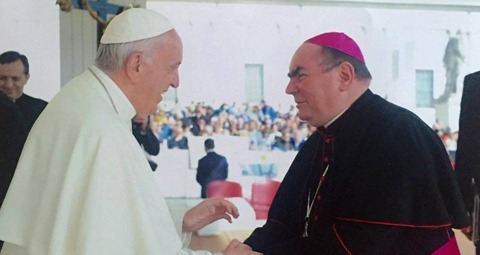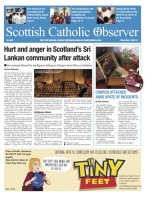BY Daniel Harkins | September 28 | ![]() 0 COMMENTS
0 COMMENTS ![]() print
print

To the threshold of the apostles: Scotland’s bishops in Rome
Scotland's bishops met Pope Francis for two hours in Rome on Thursday, as they began their Ad Limina pilgrimage. Archbishop Philip Tartaglia said the Pope 'encouraged us to share our experiences as pastors and leaders and took a close interest in all that we had to say.' Ahead of the visit, the SCO spoke to Bishop Joseph Toal of Motherwell about what the pilgrimage would entail, while Bishop Emeritus Peter A Moran looked back at the 2003 Ad Limina and meeting Pope John Paul II
Bishop Joseph Toal was only two years in the job overseeing Argyll and the Isles Diocese when he was called to Rome along with the rest of Scotland’s bishops to meet Pope Emeritus Benedict XVI.
Eight years later, and now Bishop of Motherwell, he travelled to the Vatican this week to speak about a much-altered Scotland, to a significantly different pope.
The visit is known as an Ad Limina, meaning to the ‘threshold of the apostles.’ Each conference of bishops around the world is supposed to travel to Rome every five years for the Ad Limina to report on the situation in their respective countries. However, delays began to occur in the final years of St Pope John Paul II’s pontificate, owing to his ill health, and this, combined with a growing numbers of bishops around the world, has led to the eight-year gap between Scottish visits.
“We’ve been preparing for it for some time and I am looking forward to it,” Bishop Toal said ahead of this week’s Ad Limina. “It is an important moment for us to go on pilgrimage, to celebrate Mass at the tombs of the apostles, and to visit the Holy Father and the various offices and commissions in Rome.”
Bishop Toal and Archbishop Philip Tartaglia of Glasgow, the president of the Bishops’ Conference of Scotland, are the only two of Scotland’s current serving bishops who took part in the 2010 Ad Limina. The marked change in the Bishops’ Conference underlines how long the eight-year gap has been, with many significant events in the Church in Scotland, in civic society, and in the Vatican.
The most disruptive change in the Church in Scotland has been the resignation of Cardinal Keith O’Brien, while in the secular society the country has been through an independence referendum and a vote to leave the European Union.
Bishop Toal said it is likely these topics will be discussed, with a report to the Secretariat of State—which performs all the political and diplomatic functions of the Holy See—discussing the political issues in Scotland.
The English Bishops will travel to Rome for their Ad Limina at the same time as their Scottish counterparts, as they did in 2010. It was in an address to those bishops that Pope Benedict formally confirmed that he would be visiting the UK in 2010, with a Scottish visit announced a few days later during the pope’s meeting with the Scottish bishops.
No such announcement is expected this time around, but the visit—which will last from Tuesday September 25 to Friday October 5, with the bishops staying at the Scots College—will be intensive, as the bishops do the rounds, sometimes individually and sometimes in groups, of 24 different Vatican dicasteries.
The bishops have each prepared extensive reports in advance on their diocese, including statistical information and personal testimony from the bishop. In Rome, they will report on issues including the state of the Church, the laity, and clergy as well as topics such as liturgy, justice and peace and the environment. At these meetings the bishops will speak in some cases with cardinals in charge of Vatican departments, as well as with other more junior officials.
Bishop Toal said one of the prominent issues to discuss would be the secular culture in Scotland. “There are issues with how strong the Church is now and the decline and practice in the Faith,” he said.
Prior to these meetings, the bishops will speak with Pope Francis as a group on Thursday September 27. Under Pope Benedict, bishops would each have a one-on-one-meeting with the Holy Father during an Ad Limina, however Pope Francis changed this to a group meeting.
Bishop Toal said that when he met with Pope Benedict, ‘there was a map of Scotland on his desk with each diocese marked, and you’d point out your diocese and tell him about it.’
“Pope Benedict was a teacher,” he added. “And he was interested in education, and asked about our schools. He was very professed in his English; it was informal and there was no need for an interpreter.”
He added that the Ad Limina is an opportunity for Rome to learn from Scotland as much as for the bishops to take direction from the Vatican.
“We are quite keen to convey to [the pope] what we’ve done with safeguarding,” he said, referring to In God’s Image, the Church in Scotland’s document on protecting children and adults from abuse. “We are a small country and a small bishops’ conference but we’ve done a lot of work in this area in comparison to others. Of course it might not be enough for some, but we have been quite diligent and have done what was asked of us.”
The bishops will also champion Scotland’s Catholic education system, in the centenary year of state-funded Catholic schools, and Bishop Toal said he will mention the Caritas Award, which was established after Pope Benedict’s visit to Scotland, and sees thousands of pupils each year, Catholic and non-Catholic, go on a Faith journey.
“I’m looking forward to it,” Bishop Toal said about the Ad Limina. “It’s important to have the community come to meet the Pope and show that we are still present in Scotland despite the ups and downs that we’ve faced.”
Bishop Peter A Moran remembers his 2003 Ad Limina Visit:
As today’s diocesan bishops of Scotland travel to Rome for their Ad Limina visit, I have been asked for my recollection of my visit long ago.
In 2003, Aberdeen Diocese was between bishops—I was the diocesan administrator i.e. the caretaker—but Rome, when asked, said I was expected to join the group. We flew out on Sunday March 2 and lodged in the Domus Sanctae Marthae, a clergy hotel within Vatican City. At that time, unlike nowadays, the Pope did not reside there.
On Monday morning at the early hour of 7.30am Vatican time (when our body-clocks told us it was 6.30am!) we concelebrated Mass close to St Peter’s tomb in the crypt of St Peter’s basilica. This was the first of our two statutory visits to the thresholds of the Apostles. By mid-morning I was fully awake, which was just as well, because up on the third floor of the Vatican we each had an individual meeting with Pope John Paul II!
Polish assistance
Across to Santa Marta to freshen up, and we were back as guests of the Pope at a private lunch. The Pope was already suffering from what proved to be his fatal illness, and dining with us was the Holy Father’s personal assistant Archbishop Stanisław Dziwisz. As it happened, three years later when he was Archbishop of Kraków, I visited him there to ask him to send a Polish priest to help us in Aberdeen, amid rumours (which proved to be true) that he would be nominated cardinal the very next day. He sent Fr Ryszard Swider almost immediately. Fr Ryszard was one (the first, I think) of over a dozen Polish priests who served, and some of whom are still serving, in the Diocese of Aberdeen.
That same evening we were at the Scots College for the formal opening of the extended library, of which Sir Tom Farmer was a major benefactor.
Next morning we were again with the Holy Father, concelebrating Mass at 8am in his private chapel, followed by a group audience with him. At 11am we had the first of our meetings with seven of the Vatican ‘departments’—courteously received at the Congregation for the Doctrine of the Faith (CDF) round a polished table in their airy offices. Here our secretary Mgr Henry Docherty was greeted on first name terms by his former boss, then Archbishop Joseph Ratzinger, later to be Pope Benedict XVI. In the evening we were the guests of Kathryn Colvin, UK ambassador to the Holy See, where the late Bishop John Mone entertained us all with an impressive impromptu recital at the ambassadorial grand piano.
On the Wednesday we attended a meeting (Council for Justice and Peace) in one of the palazzi which, although surrounded by the buildings of Rome, is a small extraterritorial piece of Vatican City, and then were shown round the world HQ of Caritas Internationalis by Duncan MacLaren who was then its general secretary, and lunched with him.
March 6 saw us at the Congregation for Divine Worship where among other matters I asked them when on earth the new English-language missal would be ready! At midday I lunched with my sister, Sr Elizabeth. She is a Columban Missionary sister but at that time was seconded to the Education and Mission section of the World Council of Churches in Geneva, and happened to be in Rome on WCC business.
In the afternoon the Scottish bishops made the second of their two statutory visits to the thresholds of the Apostles by celebrating Mass at St Paul’s Outside the Walls. We also visited the Pontifical Beda College where some Scottish seminarians study, as it is just across the road from that Basilica.
Secretariat of state
Friday 7 was our last full day in Rome, with visits to two more congregations (education and clergy). At the Congregation for the Clergy I was able to raise a question about the group of Redemptorists on the island of Papa Stronsay in Orkney in the Diocese of Aberdeen. There was some uncertainty at that time about their situation, concerns now satisfactorily addressed. We also fitted in a visit to the Secretariat of State where I remember being very impressed with how well informed Mgr Peter Parolin (now Cardinal Parolin) was about the United Kingdom.
One trivial but (for me, as a former Classics teacher) memorable moment was finding, in a small branch of the Vatican Bank, a cash machine where the instructions were in half a dozen languages including Latin.
Saturday was the day we flew back to Scotland. Although I was 15 years younger then than I am now, this week in Rome, though fascinating, had been utterly exhausting.










